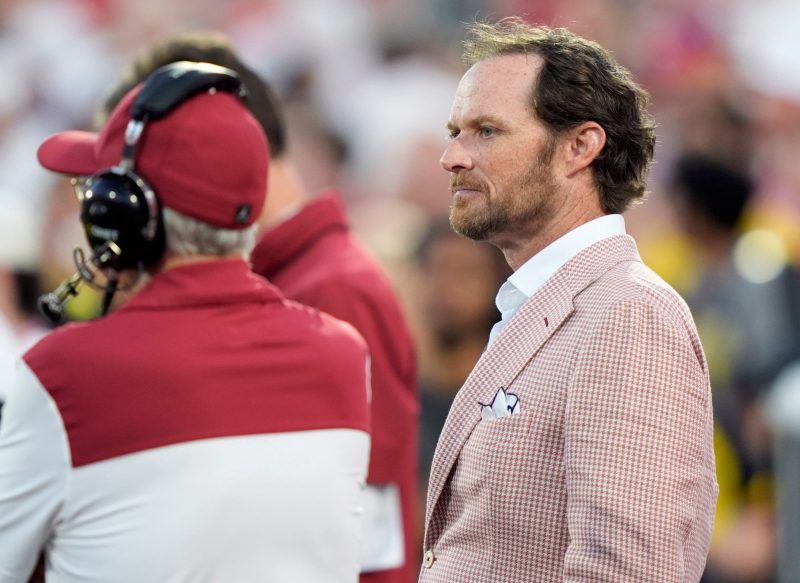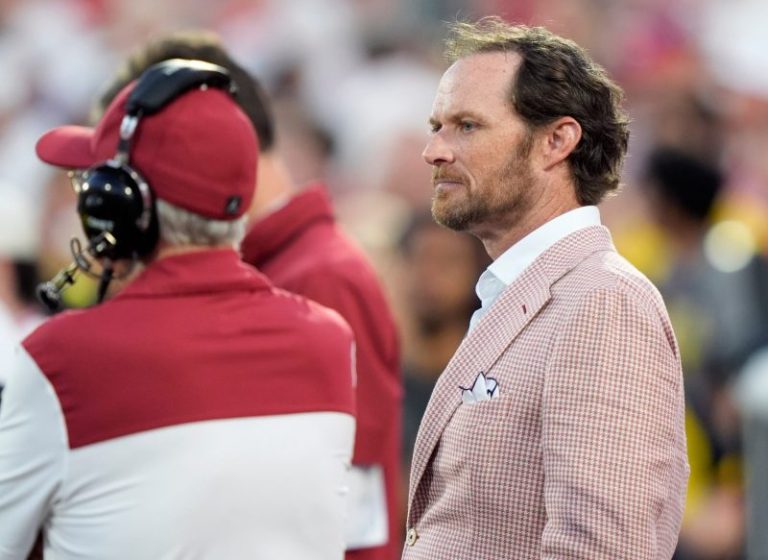
- College football programs are increasingly hiring general managers to navigate the new era of NIL and revenue sharing.
- Schools are bringing in executives from the NFL, business world, and other sports to build out their front offices.
- Virginia Tech initially considered hiring a general manager before a head coach but ultimately reversed course.
- Some coaches, like Indiana’s Curt Cignetti, prefer to act as both head coach and general manager.
Bruce Arians, the former NFL coach advising Virginia Tech since it fired former coach Brent Pry last month, went on ‘The Pat McAfee Show’ and suggested the school had a plan that would have been seen as radical just a few years ago.
The Hokies would hire a general manager before conducting their head coaching search, Arians said, because ‘the whole thing has changed. It’s all business now and you’ve got to find a businessman.’
Only 10 days later, current Virginia Tech athletics director Whit Babcock announced the university had switched course and would take the more traditional approach of forming a search committee to help identify a new coach first. Virginia Tech had found having a general manager in place first could limit the school’s head coach candidate pool, according to Babcock.
‘We want to be cutting edge, but not leading edge,’ Babcock explained on a Virginia Tech athletics department podcast.
Neither idea resembles the more unconventional response another public school and in-state ACC rival implemented over the past year to confront the financial and competitive complexities introduced to college sports in recent years by NIL and revenue sharing.
Virginia football is back in the national polls for the first time since 2019 with the help of Tyler Jones, an athletic department administrator elevated into the role of general manager for football and women’s basketball. Once a potential player is identified by coaches as an option for either roster, it’s Jones who serves as a recruiter, ‘just explaining to folks what UVA is about, our roster situation and detailing out what our financial package could look like,’ he said on the Inside Virginia Athletics podcast with athletics director Carla Williams in July.
The Virginia athletic department also hired former New England Patriots executive Scott Pioli to help construct its new model, and he remains a paid consultant for the department with an 11-month contract worth $330,000 through June 30, 2026, according to documents obtained by USA TODAY Sports via open records request.
“We didn’t want to be the first school to just jump out there and hire people,’ Williams said on the podcast.
College football is still very much in the feeling-out process of how to best capitalize on the strange, new world born from the once-forbidden concept of having to pay players. It’s perhaps best reflected in the lack of consensus to this point about the best way to build out a front office equipped to handle this professionalized version of the sport.
As part of its annual survey of college football coaches compensation, USA TODAY Sports also obtained contracts and 2025 salary information for Power Four conference general managers at public schools this year — or in lieu of that exact title, the staff member identified as the top front-office member at each school. The growing range in salary, structure and responsibilities revealed in these documents offer a glimpse into the resources and rapid evolution transpiring behind the scenes.
Many schools are bringing in personnel from the NFL, business world and beyond to spearhead a program transformation off the field. Here’s a look at some of the most elaborate and interesting front-office structures in college football during the 2025 season:
California turns to Ron Rivera
After Cal football’s first season in the ACC, and four months following rival Stanford’s splashy hiring of Andrew Luck as its football general manager, Cal chancellor Rich Lyons lured alum Ron Rivera back to campus as the Bears’ first general manager last March. The former Washington Commanders and Carolina Panthers coach took on a wide-ranging role with personnel responsibilities and hiring power within the football program similar to an NFL general manager, as well as more traditional fundraising duties tied to the university’s NIL and revenue-sharing programs.
Rivera’s job also includes, it appears, the ability to determine the future of current Cal coach Justin Wilcox. The school’s announcement of Rivera’s hiring noted he reported only to the university chancellor. When asked who had ‘ultimate authority’ within the football program, Rivera told reporters last April, ‘I do have that, other than the chancellor.’
‘One thing everybody has to understand,’ Rivera explained, ‘is I do have the opportunity working with the chancellor to make decisions on what is best for Cal football, because my hands are in every facet of Cal football.’
Oklahoma calls on former AT&T, Senior Bowl executives
Oklahoma made significant changes to its football infrastructure over the past year in an effort to fuse some of the best practices from the NFL, college football and corporate world together within the dynamic landscape created by the implementation of NIL and revenue sharing. The university’s unorthodox move was to hire former AT&T chairman and CEO Randall Stephenson as a special advisor to the president and athletics director. His role has expanded since the Sooners made an intriguing general manager hire to spearhead their front office build-out.
Stephenson currently carries the title chair of football and provides day-to-day oversight of new Oklahoma general manager Jim Nagy and Sooners football coach Brent Venables. Stephenson also offers ‘oversight and expertise of the budgeting, strategic planning and business planning functions during this unique time of change in college athletics,’ according to the university.
Nagy is the former executive director of the Senior Bowl and a longtime NFL scout who now leads Oklahoma’s roster management and player acquisition. He also manages issues related to NIL, the transfer portal, revenue sharing, scholarship limits and eligibility requirements. The Sooners also previously created a partnership with former Philadelphia Eagles vice president of football administration Jake Rosenberg when it elected to change the structure of its football program.
Washington consults sports agent, former NFL GM
Washington football doesn’t have anyone with the title of general manager on coach Jedd Fisch’s 2025 staff, and Matt Doherty serves as the program’s senior director of player personnel. But the athletic department has been aggressive trying to address its NIL and revenue-sharing needs.
Last February, athletics director Pat Chun hired Cameron Foster as the school’s senior director of contracts and cap management. Foster, a longtime sports agent primarily focused on NFL clients, serves as Washington’s lead negotiator on revenue-share agreements, according to the university. He is also still actively working for Reign Sports Management and signed a one-year contract with Washington through February 2026. The employment agreement includes a salary of $150,000 and a clause that states his ‘primary obligations lie with the University and its students.’
Fisch also previously brought in The 33rd Team, an NFL think tank led by former New York Jets general manager Mike Tannenbaum, as an outside consultant. Washington has paid Tannenbaum’s company more than $155,000 since Sept. 1, 2024, according to documents obtained by USA TODAY Sports, but the current contract expires at the end of October.
‘We wanted to bring in somebody that had no real motives, nobody really connected to our program substantially,’ Fisch said in December 2024, ‘but also somebody that can help guide (Doherty) and myself in making some critical financial decisions as we’re now budgeting close to $15 million or more to take care of players.’
Matt Rhule brings familiar GM to Nebraska
Matt Rhule came to Nebraska in 2023 after an unsuccessful stint as Carolina Panthers coach, but those NFL ties are coming in handy with the annual negotiations necessary in player acquisition and retention in college football.
Rhule made Pat Stewart one of the highest-paid public school general managers in a P4 conference when he hired Stewart last March at Nebraska, according to USA TODAY’s compensation survey. He was the vice president of player personnel for the Panthers under Rhule and has been dubbed ‘a key part of a re-organization of the Huskers’ front-office staff’ by Nebraska officials.
Stewart signed a three-year deal and will earn a base salary of $800,000 in 2025, with the opportunity to make an additional $200,000 in performance incentives according to a copy of his contract obtained through an open records request.
Louisville poaches from in-state rival
Vince Marrow made waves last June when he left his job as an assistant coach at Kentucky after 12 years to become Louisville’s executive director of football personnel and recruiting under coach Jeff Brohm, his friend and former XFL teammate. Marrow’s new bosses got a little creative in order to lure him away and make the money work.
Marrow signed a three-year, $2.4 million contract with Louisville that begins with a $700,000 base salary this season and includes an annual $100,000 salary increase. But the agreement also stipulates he ‘is entitled to receive additional compensation from private entities outside the University.’ Marrow told The Louisville Courier Journal the outside income would come from one entity, which he declined to name, and increases his annual financial package to more than $1 million. He was set to earn $1.3 million had he remained at Kentucky this season.
Marrow left an on-field role after 20 years as a coach to become Louisville’s de facto general manager, overseeing roster construction through high school recruiting and the transfer portal. Louisville is also paying $150,000 to former NFL executive and sports agent Andrew Brandt to help the athletic department develop and negotiate revenue share contracts for its student-athletes as part of a consulting contract with the school through the end of 2025.
‘I really believe this is where college football is going,” Marrow said at his introductory news conference. ‘You don’t have enough time to really find out what’s the background of these guys. … I really believe the time now that I don’t have to spend in coaching, I can just spend a lot of time evaluating guys and then getting that background stuff.”
Arkansas football leans on NBA scouting director
Though Arkansas is the midst of a coaching change after firing Sam Pittman last month, athletics director Hunter Yurachek had already made an unorthodox hire last March that will factor into the hiring process. Arkansas tabbed Boston Celtics executive and director of scouting Remy Cofield as a deputy athletics director and its general manager for Razorbacks athletics. He serves as lead negotiator for revenue-share agreements and collaborates with coaches to develop strategic roster plans, with the goal to eventually hire a football-specific assistant general manager as part of the athletic department’s front office.
Cofield’s contract includes a provision in which he can earn up to $100,000 per year in bonus compensation based on the performance of the football, men’s basketball, women’s basketball, baseball, softball and gymnastics programs at Arkansas.
Curt Cignetti is ‘GM and head coach’ at Indiana
Indiana coach Curt Cignetti made it clear at Big Ten football media days this year the Hoosiers will not be changing their approach to roster-building simply because others are building out more elaborate front offices. Cignetti declared ‘I’m the GM and head coach’ when asked in July about how Indiana planned to handle revenue sharing moving forward.
‘I’m a control freak,’ Cignetti added. ‘I’m organized, I’m good with numbers. My name is on this. I spent a lot of years getting to this point, I’m the best one to do it.’
Louisville Courier Journal sports reporter Payton Titus contributed to this story

